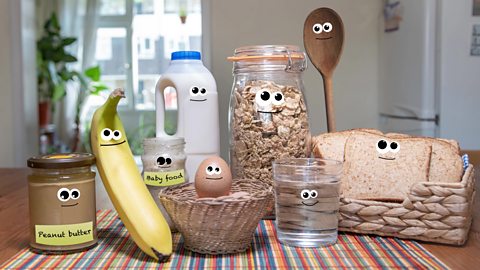What are the main food groups?
Food groups are created by grouping together foods with similar nutritional values.
How many food groups are there?
The five main food groups are:
- Fruit and vegetables
- Carbohydrates
- Proteins
- Dairy
- Fats and oils
Video - What are the food groups?
In this video, the Great Spoon is hosting a fun food groups quiz. Learn about the five different food groups and some examples of food that belong to each of them.
Find out about the five food groups in this video.
THE GREAT SPOON Ladies and gentlemen, knives and forks…Tonight… We quiz!
EVERYONE CHEERS
THE GREAT SPOON There are five food groups. Each of you belong to one of these groups! In order to find out which group you belong to we shall quiz like we have never quizzed before! If you think the riddle is about you then, shout “ME!” and name the type of food you think you are.
EGG Me!
THE GREAT SPOON We haven’t started yet, Egg. OK so riddle one…
“Butter me, toast me, enjoy me for my vitamin B”
BREAD Me! Carbohydrates!
THE GREAT SPOON Correct Bread! You make a tasty toasty breakfast or a yummy sandwich lunch. And you’re a carbohydrate so you keep energy levels up. Please go and join your fellow carbohydrates.
CARBOHYDRATES CHEER
THE GREAT SPOON Riddle two…
“I’m a calcium king who can be melted and grated!”
STRAWBERRY Me! Fruits and vegetables!
THE GREAT SPOON Oooh incorrect, Strawberry. Any other guesses?
CHEESE Me! Dairy!
THE GREAT SPOON Correct! Well done, Cheese! Calcium in dairy helps keep bones strong! Go and see your fellow dairy friends.
DAIRY CHEERS
THE GREAT SPOON Riddle three…
“I can be one of your five a day. I’m stuffed to my green tips with vitamin C and iron. I look like a tree but luckily I don’t taste like one!”
EGG Broccoli, you look a bit like a tree.
BROCCOLI Me! Fruit and vegetables!
THE GREAT SPOON Spot on! Nice one, Broccoli. Fruit and vegetables are stuffed with vitamins and fibre that keep the digestive system working. Go and take a seat with the other fruit and veg!
FRUITS AND VEGETABLES CHEER
THE GREAT SPOON Riddle four…
“Spread me, bake with me, keep me in the fridge. Once upon a time my main ingredient was inside a cow!”
BEANS Beans!
THE GREAT SPOON Ummmm, no, Beans. You’re a protein…and you’ve never been inside a cow…
BEANS µţ±đ˛ą˛Ô˛ő…
BUTTER Me! Butter! Fats and oils!
THE GREAT SPOON Correct! Fats and oils store energy, keep people warm and protect organs like their hearts and lungs. But they’re best enjoyed in small portions! Pull up a seat with the other fats and Oils.
FATS AND OILS CHEER
THE GREAT SPOON Time for our last riddle:
“Cracking me is good to get the gold goo inside! Scramble me or boil me and gobble up my nutrients.”
BEANS µţ±đ˛ą˛Ô˛ő…
EGG Me! Me! Protein!
THE GREAT SPOON Correct! It is your time to shine, Egg. Eggs, beans and other proteins help build and repair bones, muscles, skin, and even blood! Congratul–
EGG CRACKS
EGG Sorry… I got overexcited.
THE GREAT SPOON Not to worry wee one.
PROTEINs CHEER
THE GREAT SPOON So, a healthy diet has lots of fruits and vegetables like broccoli. It has plenty of carbohydrates like bread potatoes, or pasta.
Some portions of protein should be eaten everyday - like eggs, meat or fish…or beans! And also it is important to eat some dairy - milk, cheese, or yoghurt. Or grab an alternative, like soy milk or oat milk.
It’s healthy to have a small amount of fat and oil. And a bit of sugar. Not too much though or your body might not work as well as it should!
Wow! What a delicious and colourful crew! You all look good enough to eat!
What is a healthy diet?
We need variety and balance in our diets. We should enjoy foods from each of the five food groups to stay healthy.
Every meal we eat does not need to be perfectly balanced. However, over the course of a day or a week, we should be consuming the recommended amounts for good health.
Here is a chart showing the five food groups and some examples of foods in each group.
Benefits of the different food groups
Each of the five food groups serve a different purpose in helping our bodies with the functions it needs to keep working.
Fruits and vegetables
Fruits and vegetables provide fibre which we need to help digestion. They are also packed with vitamins and minerals to support a healthy immune system. For example:
- vitamin A supports good eyesight and can be found in spinach, carrots, sweet potatoes and red peppers.
- vitamin C is great for skin repair. Good sources of vitamin C include oranges, strawberries and blackcurrants.
Carbohydrates
Carbohydrates provide us with all the energy we need for everyday activity and bodily functions.
Proteins
Foods that contain protein help our bodies grow, repair and make new cells. Eating from this food group will give you healthy muscles.
Dairy and dairy-free alternatives
These foods are great for the health of our bones. We get calcium from dairy and many dairy-free alternatives have calcium added to them. Calcium gives us strong bones and is good for our teeth.
Fats and oils
Fats and oils give us an energy store and essential fatty acids. This allows our bodies to absorb vitamins we get from other food groups.
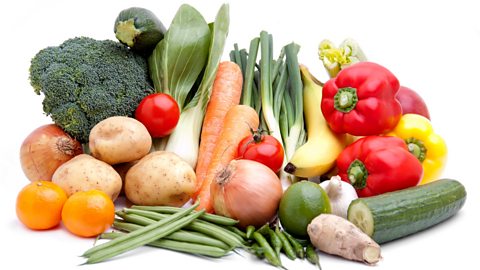
Image caption, Fruit and vegetables
Fruit and vegetables are packed with minerals and vitamins. They also provide fibre which we need to help digestion.
Image caption, Carbohydrates
Carbohydrates provide us with all the energy we need for everyday activity and internal bodily functions, such as our nervous systems, kidneys etc.
Image caption, Proteins
Foods that contain protein are essential for our bodies to grow, repair and make new cells. Eating from this food group will give you healthy muscles.
Image caption, Dairy and dairy-free alternatives
Dairy products are great for the health of our bones. We get calcium from dairy and that gives us strong bones. Dairy is also good for our teeth.
Image caption, Fats and oils
Fats and oils give us an energy store and essential fatty acids, which allow our bodies to absorb the vitamins we get from other food groups.
1 of 5
What are the NHS guidelines around food and diet?
Current health guidelines from the NHS encourage us to eat:
- at least five portions of fruit and vegetables a day
- three servings of dairy like milk, yoghurt or cheese
- three to five servings of carbohydrates. These should ideally be high fibre options, such as wholemeal brown bread and wholemeal pasta
- two to three servings of protein rich foods per day. Make sure over the week you are having some protein, such as oily fish or beans, like kidney beans
- a small amount of oils and spreads
What is fibre?
- Dietary fibre is plant material that cannot be digested by the body.
- Dietary fibre helps the digestive system to move the food we eat through the intestines and push the waste material out of the body.
- Foods that are rich in fibre include beans, pulses, and vegetables, such as broccoli and carrots.
Learn more about our digestive system here: How do humans digest food?
Which foods are less healthy?
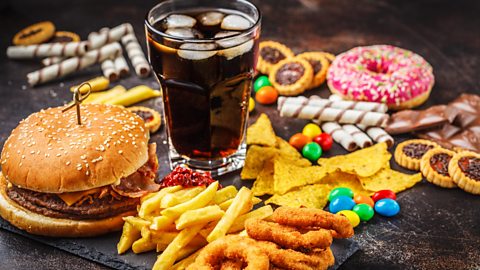
Foods that are high in sugar, salt and fat, like crisps and cakes, are not included in the five food groups. These are foods that we should eat less of as occasional treats because they do not provide our bodies with any nutrients.
Too much sugar and fat can make us gain excess weight and too much salt is bad for our blood pressure.

Why is water an important part of a healthy diet?
Along with eating a healthy balanced diet we should be drinking lots of water. Our bodies are made up of over 60% water, some of which is lost through breathing, sweating and going to the toilet. We need to replace it for our bodies to function properly and keep us hydrated.
Find out more about why drinking water is an important part of our health and wellbeing: Why do we need water?
Test your knowledge
Try this short quiz to check your knowledge of the five food groups.
Challenge - Design a balanced meal
Create a healthy balanced meal that includes all the five food groups.
Remember to include something from the five food groups:
- Fruit and vegetables
- Carbohydrates
- Proteins
- Dairy
- Fats and oils
You might want to think about a main meal, such as lunch or dinner, and a healthy snack/dessert.
For example:
- A sandwich made with brown bread (carbohydrates) filled with ham (protein), cheese (dairy) and salad (fruit and vegetables) followed by a piece of fruit as a snack.
More on Food and health
Find out more by working through a topic
- count2 of 10
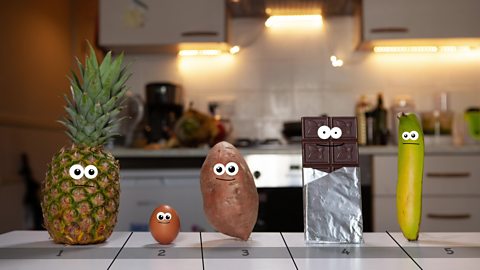
- count3 of 10
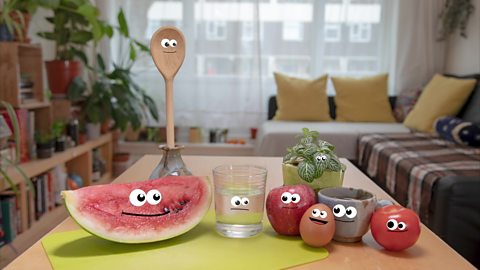
- count4 of 10
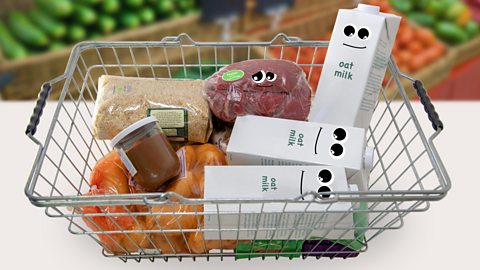
- count5 of 10
